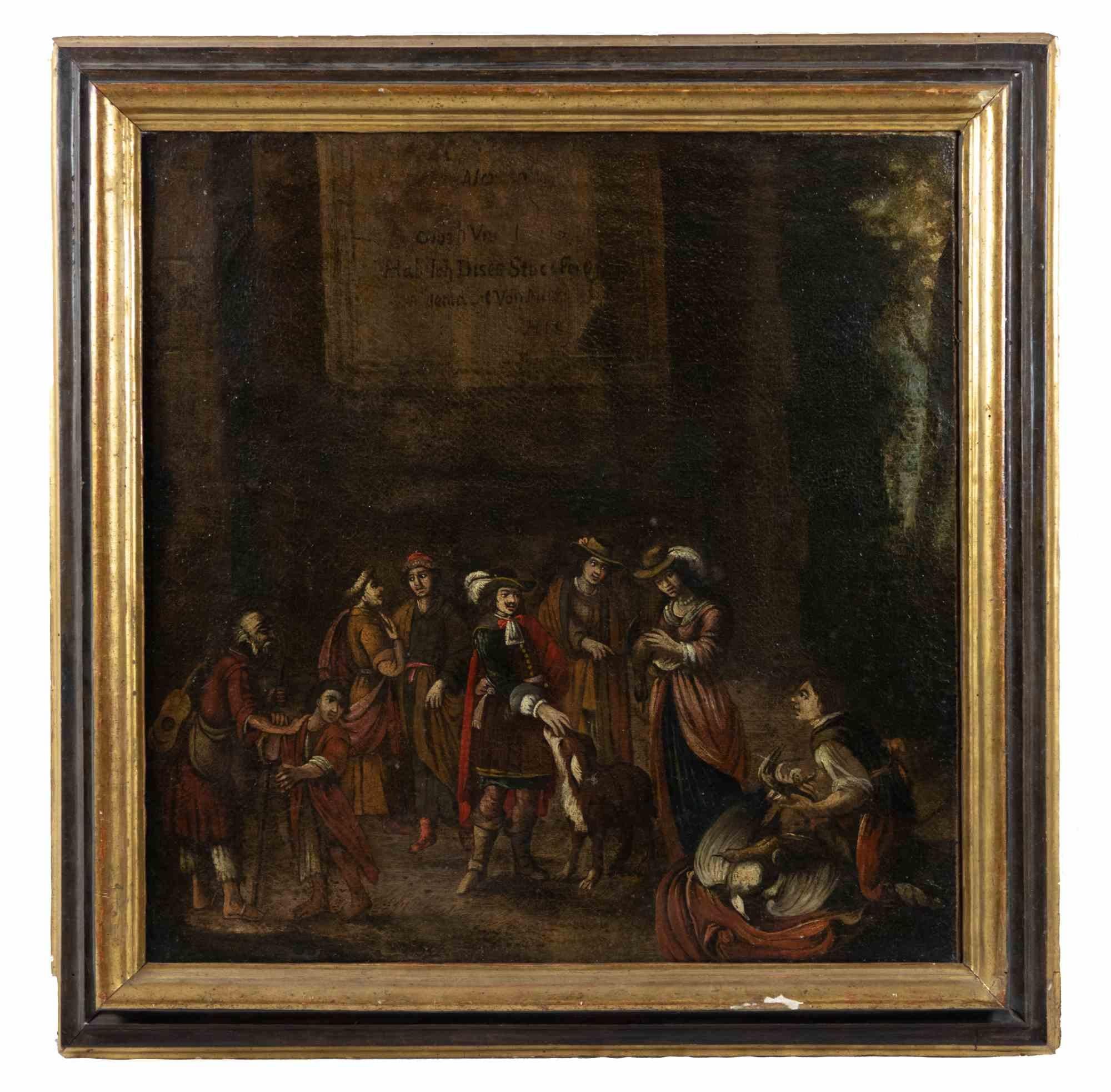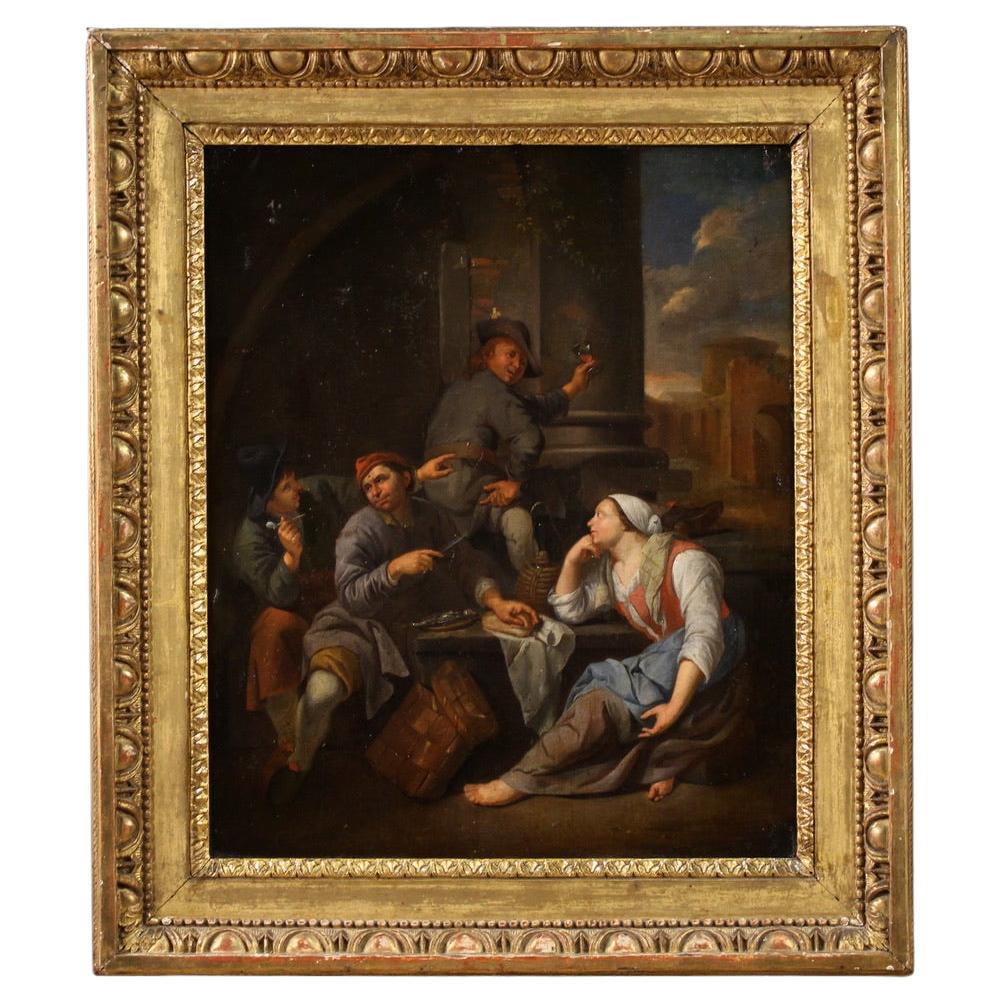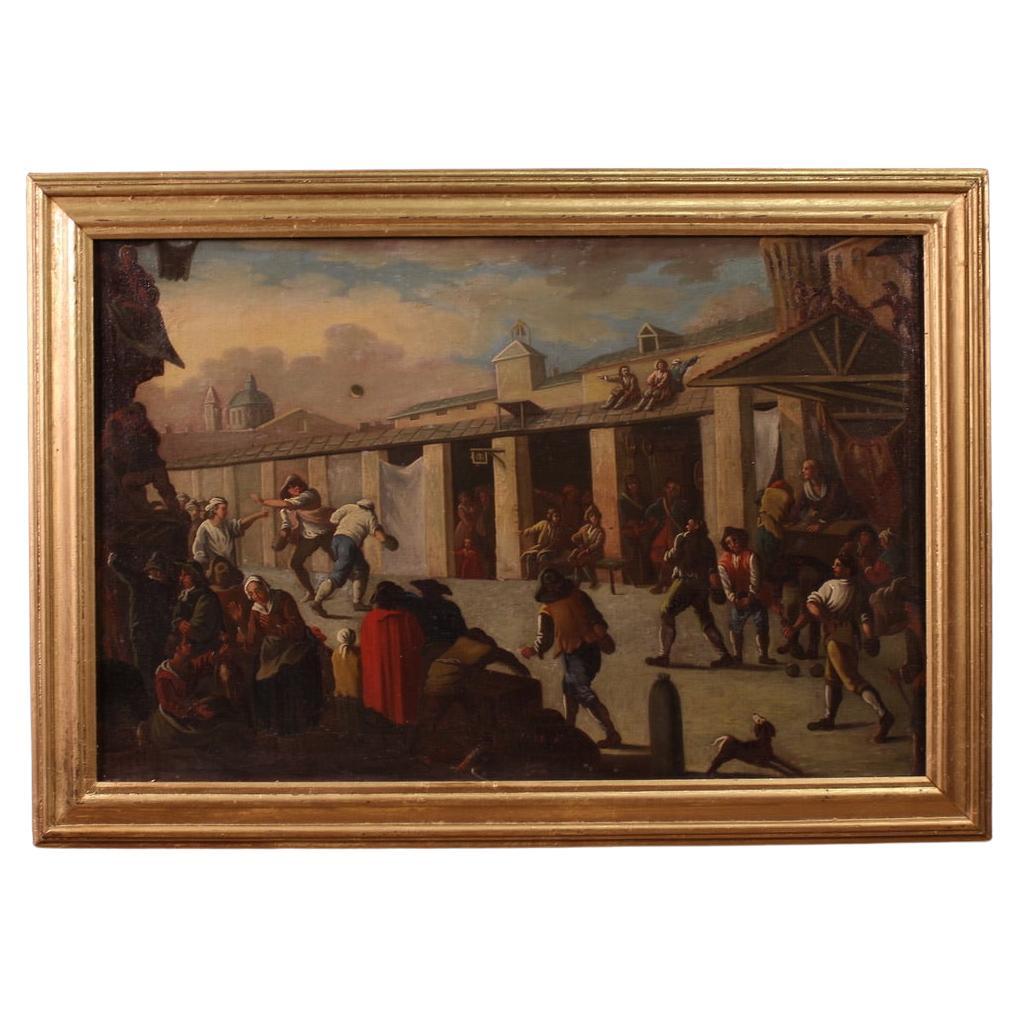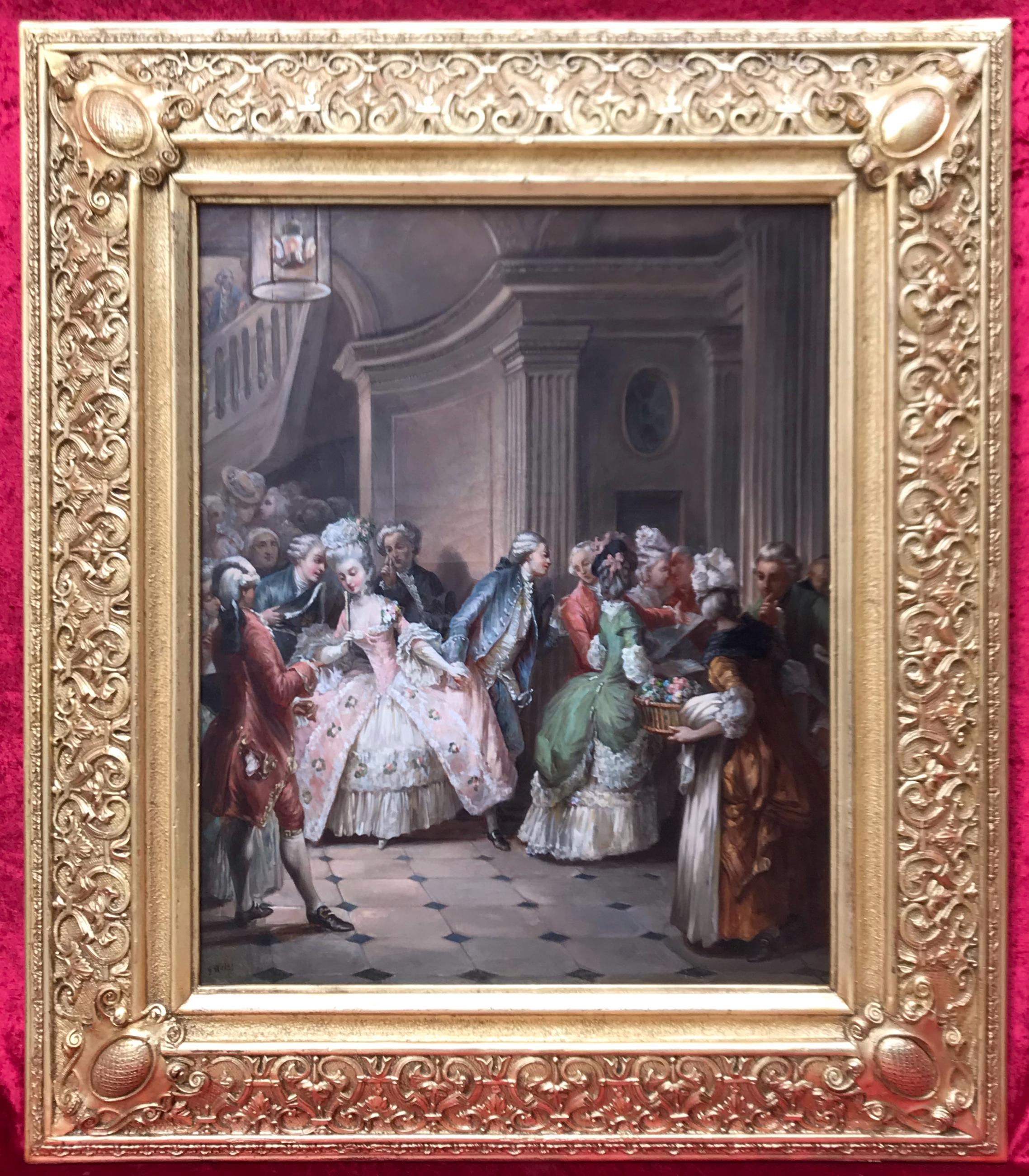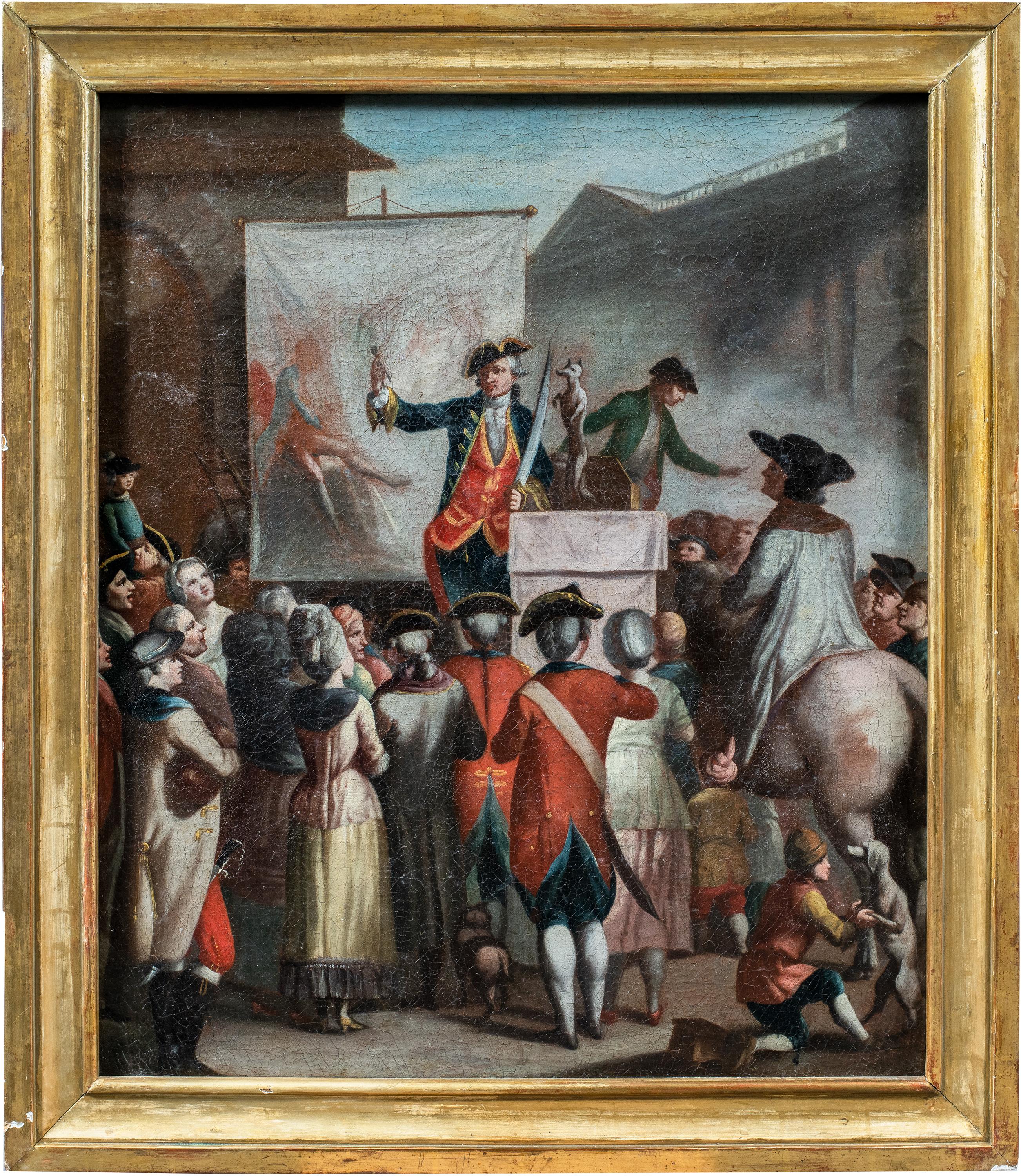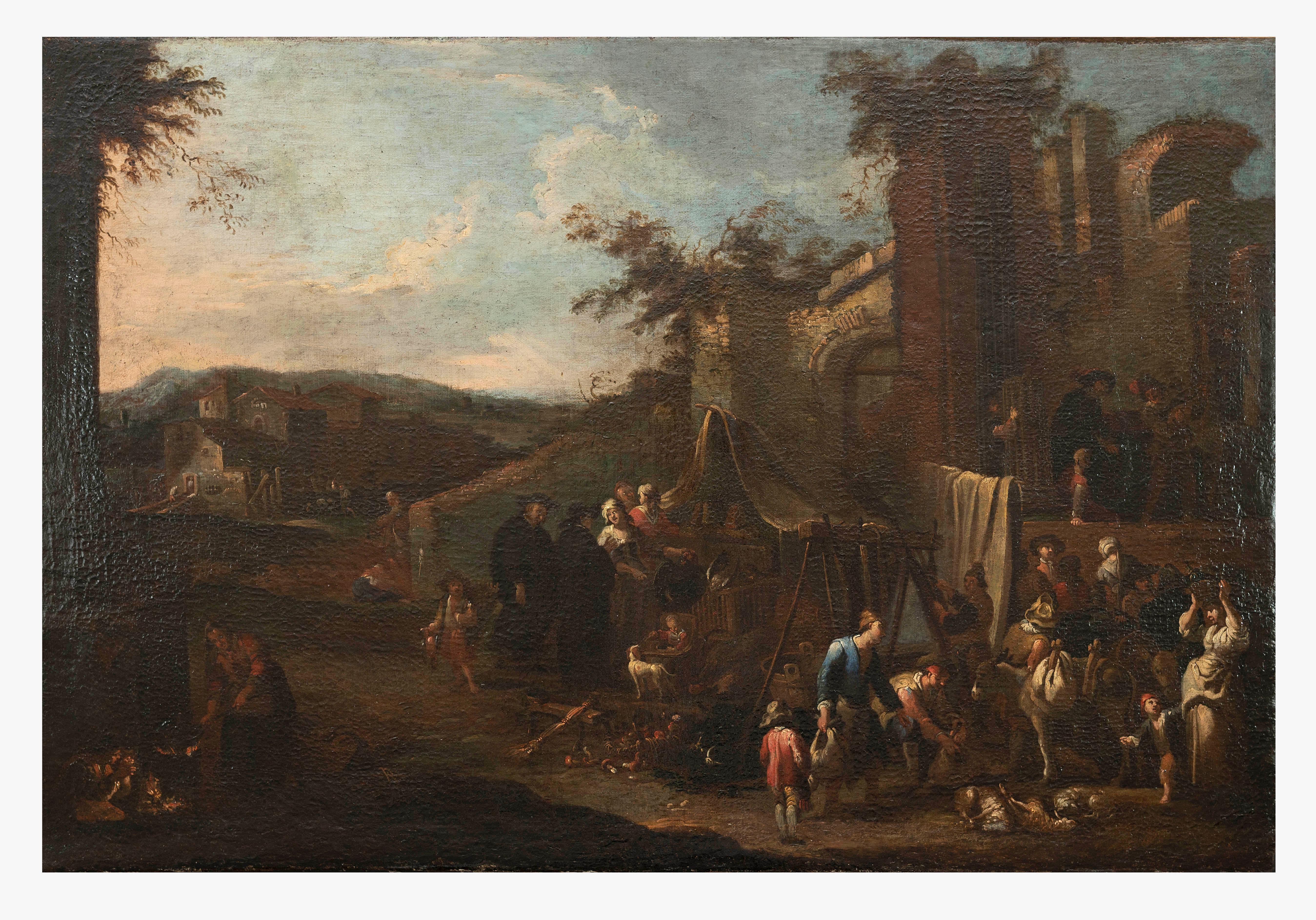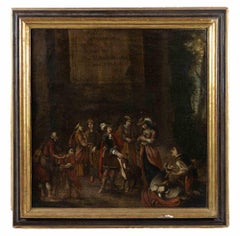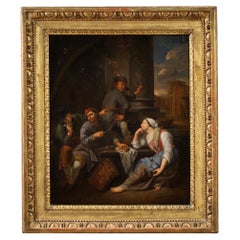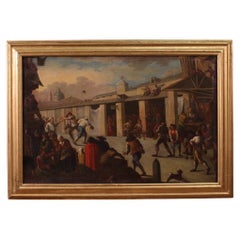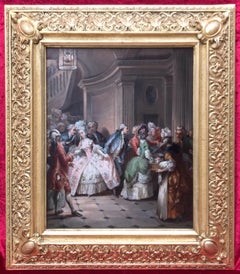Items Similar to Important 18th Century Royal Academy Oil Painting of Georgian London Festival
Want more images or videos?
Request additional images or videos from the seller
1 of 18
Richard Morton PayeImportant 18th Century Royal Academy Oil Painting of Georgian London Festival1788
1788
$341,055.58
£249,000
€292,671.05
CA$470,873.27
A$522,032.64
CHF 274,348.52
MX$6,388,823.37
NOK 3,426,334.08
SEK 3,215,957.36
DKK 2,184,607.66
About the Item
‘St. James’ Day’ by Richard Morton Paye (1750-1820).
This large and important 18th century oil on canvas depicts a diverse crowd of Londoners at an oyster stand on a summer’s evening. The artist’s masterpiece, the painting was exhibited at the Royal Academy in London in 1788. The street festival of St. James’ Day commenced at midnight on August 5th and was known as London’s ‘Oyster Day’.
A short film about the painting and its recent rediscovery and restoration is available to view at the Academy Fine Paintings website.
Richard Morton Paye was one of the most gifted and innovative painters of early English School. ‘St. James’ Day’ is a wonderful record of life in London during the reign of King George III and is sold with provenance of ownership dating back over 240 years.
Academy Fine Paintings only offers artwork for sale in the finest condition it can be for its age, having been professionally cleaned, conserved, and re-varnished. Clients should also note that tracked and signed for international shipping is complimentary.
The Festival of St. James’ Day (August 5th) marked the start of the oyster season in England and the celebrations – which included much drinking of alcohol as well the eating of oysters – began every year London at the stroke of midnight.
About the Artist...
A contemporary (and rival) of Joshua Reynolds and Thomas Gainsborough, Richard Morton Paye was an innovative and skilful painter of scenes of everyday London life, often featuring children. Between 1773 and 1802 he exhibited 64 times at the Royal Academy, yet today, known works of his are few and far between.
In ‘St. James’ Day’ Paye uses the opportunity to take out his frustration with patrons and the self-appointed connoisseurs of the London art world by lampooning both. In the background, to the left, a well-to-do gentleman is being accosted by a drunkard who humiliates him by pulling off his wig. New research into the painting has revealed the man to be the most powerful art collector of the age, John Julius Angerstein (1735-1823) of whom Richard Morton Paye was clearly not a fan. Meantime, to the lower right, a vicious dog is pictured stealing a chicken and written on its collar is the word “critick”. It is worth noticing that Paye was also capable of turning his acerbic wit upon himself. Seen on the far left, looking directly out at us, is the artist himself, distracted by public attention and clearly unaware that he is being robbed by a pickpocket.
Dimensions: (framed) 127cm x 142cm (50” x 56”)
Dimensions: (canvas only) 102cm x 119cm (40” x 43”)
Medium: Oil on canvas.
Provenance: 1788; purchased by William Clay, Esq. of Upper Gower Street. (1748-1824). 1824; purchased by Johnson at Christie’s 5th June, lot 95. Julius Ernst Guthe, Kepwick Hall, Thirsk, North Yorkshire (1857-1917). Julius Ernst Guthe, Jr., Kepwick Hall, Thirsk, North Yorkshire (1885-1975). Digby J. E. Guthe, Silton Hall, Neither Silton, North Yorkshire (1927-1982).
Thence by descent in private UK collection.
Presentation: Newly commissioned bespoke gold metal leaf frame. All of the new frames we commission are especially made for us to order by one of the UK’s top period frame makers.
Condition: Very good. Newly professionally cleaned, conserved and re-varnished. Ready to hang. We do not sell dirty, damaged or unframed works of art.
Conservation: Professionally restored by Simon Gillespie Studio, as seen on BBC Television's 'Fake or Fortune' and 'Britain's Lost Masterpieces'.
- Creator:Richard Morton Paye (1750 - 1820, British)
- Creation Year:1788
- Dimensions:Height: 50 in (127 cm)Width: 56 in (142.24 cm)Depth: 4 in (10.16 cm)
- Medium:
- Movement & Style:
- Period:1780-1789
- Condition:
- Gallery Location:Gerrards Cross, GB
- Reference Number:1stDibs: LU741316015782
About the Seller
5.0
Gold Seller
Premium sellers maintaining a 4.3+ rating and 24-hour response times
Established in 2012
1stDibs seller since 2017
155 sales on 1stDibs
Typical response time: 1 hour
Associations
LAPADA - The Association of Arts & Antiques DealersInternational Confederation of Art and Antique Dealers' Associations
- ShippingRetrieving quote...Shipping from: Gerrards Cross, United Kingdom
- Return Policy
Authenticity Guarantee
In the unlikely event there’s an issue with an item’s authenticity, contact us within 1 year for a full refund. DetailsMoney-Back Guarantee
If your item is not as described, is damaged in transit, or does not arrive, contact us within 7 days for a full refund. Details24-Hour Cancellation
You have a 24-hour grace period in which to reconsider your purchase, with no questions asked.Vetted Professional Sellers
Our world-class sellers must adhere to strict standards for service and quality, maintaining the integrity of our listings.Price-Match Guarantee
If you find that a seller listed the same item for a lower price elsewhere, we’ll match it.Trusted Global Delivery
Our best-in-class carrier network provides specialized shipping options worldwide, including custom delivery.More From This Seller
View AllThe Golden Egg - Early 19th Century Oil Painting of the Lovers from Mother Goose
Located in Gerrards Cross, GB
‘The Golden Egg’ by Richard Morton Paye F.S.A. (1750-1820).
The painting – which depicts the moment the young lovers in Thomas Dibdin’s Georgian pantomime discover the solid gold eg...
Category
Early 19th Century English School Figurative Paintings
Materials
Oil
Large 18th Century Oil Painting Marine Seascape of British Navy Fleet off Dover
By Dominic Serres
Located in Gerrards Cross, GB
‘The British Fleet with a Vice-Admiral of the Red off Dover’ by Dominic Serres R.A. (1722-1793).
French-born Dominic Serres didn’t just paint the drama of...
Category
Late 18th Century English School Landscape Paintings
Materials
Oil
19th Century Oil Painting of St Mark's Square in Venice from the Ducal Palaca
By Edward Pritchett
Located in Gerrards Cross, GB
‘Piazza San Marco from the Palazzo’ by Edward Pritchett RWS (1807-1876).
The painting – which depicts St. Mark’s Square and the Campanile seen from the Porto della Carta entrance to...
Category
Mid-19th Century English School Landscape Paintings
Materials
Oil
News from the Front - 19th Century Oil Painting Royal Academy 1849 Exhibition
By Frederick Goodall R.A.
Located in Gerrards Cross, GB
‘News from the Front’ by Frederick Goodall R.A. H.R.I. (1822-1904).
Academy Fine Paintings is fully conversant with the latest US Government import duties and the legal exemptions ...
Category
Mid-19th Century Victorian Figurative Paintings
Materials
Oil
Spectacular Large 19th Century Italian Oil Painting of Jerusalem & Crucifixion
By Pietro Sassi
Located in Gerrards Cross, GB
'Calvary' by Pietro Sassi (1834-1905).
This monumental exhibition oil painting – which depicts the Light of Heaven shining upon Christ at Calvary with thousands of people outside t...
Category
Mid-19th Century Old Masters Figurative Paintings
Materials
Oil
Going to Market - 19th Century Exhibition Oil Painting Woking Common in Surrey
By George Cole
Located in Gerrards Cross, GB
‘Going to Market, Woking Common’ by George Cole RBA (1810-1883). The painting is signed by the artist and dated 1853 in which year it was exhibited at the Society of British Artists ...
Category
Mid-19th Century English School Landscape Paintings
Materials
Oil
You May Also Like
The Market - Painting - 18th Century
Located in Roma, IT
The Market is an original old master artwork realized in the 18th century by an Anonymous Flemish artist.
Oil painting on canvas. The artwork depicts a bargaining scene at the marke...
Category
18th Century Baroque Figurative Paintings
Materials
Oil
18th Century Oil on Canvas Flemish Antique Painting Genre Scene, 1770
Located in Vicoforte, Piedmont
Refined Flemish painting from the 18th century. Oil on canvas artwork depicting a lively genre scene, of notable pictorial quality and rich in minute details. In a rustic setting, pr...
Category
Antique 1770s Dutch Paintings
Materials
Canvas
18th Century Oil on Canvas Italian Antique Painting Genre Scene, 1750
Located in Vicoforte, Piedmont
A splendid Italian painting from the mid-18th century. Oil on canvas, first canvas, painting depicting a lively square where an antique ball game, a precursor to ball with bracelet, ...
Category
Antique 1750s Italian Paintings
Materials
Canvas
A Party To The Castle in 18th Century
Located in Saint-Ouen, FR
A Party To The Castle in the 18th Century
Oil on canvas with a signature G.Weiss low left
Old frame regilded
Dim canvas : 46 X 38 cm
Dim frame : 66 X 58 cm
Category
Late 19th Century Academic Interior Paintings
Materials
Oil
Rococò Italian painter - 18th century figure painting - The Street Show
Located in Varmo, IT
Italian painter (18th century) - Street theater.
74.5 x 62.5 cm without frame, 86 x 73.5 cm with frame.
Antique oil painting on canvas, in a gilded wooden frame (not signed).
Cond...
Category
Mid-18th Century Rococo Figurative Paintings
Materials
Canvas, Oil
$2,971 Sale Price
47% Off
Market Scene - Oil Paint On Canvas by Pietro Domenico Olivero - 18th Century
Located in Roma, IT
Market scene is an oil on canvas realized in the first half of 18th Century by Pietro Domenico Olivero (1679-1755).
Original oil painting on canvas.
On the lower margin of the fr...
Category
18th Century Modern Figurative Paintings
Materials
Canvas, Oil
More Ways To Browse
Royal Presentation
Festival Of Britain
18th Century British Paintings
James King Artist
Antique Picture Frames London
18th Century English Oil Paintings
Reynolds Oil
Oil Painting 1820
Day Date 40 Used
Antique Oil Paintings On Gold Leaf
Antique Televisions
J King Paintings
June Leaf
Antique Chicken Art
English Gentleman Painting
Old Antique Fans
Gold Chicken
Antique Metal Records
